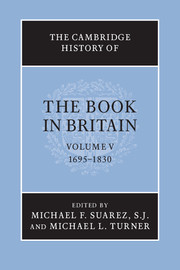Book contents
- Frontmatter
- Introduction
- PART I THE QUANTITY AND NATURE OF PRINTED MATTER
- PART II ECONOMIC, LEGAL AND CULTURAL CONTEXTS
- PART III THE TECHNOLOGIES AND AESTHETICS OF BOOK PRODUCTION
- PART IV THE BOOK TRADE AND ITS MARKETS
- V BOOKS AND THEIR READERS
- I RELIGIOUS BOOKS
- II LITERATURE AND THE CULTURE OF LETTERS
- III SPECIALIST BOOKS AND MARKETS
- 38 Collecting and the antiquarian book trade
- 39 The Stationers’ Company and the almanack trade
- 40 Children’s books and school-books
- 41 Music
- 42 Maps, charts and atlases in Britain, 1690–1830
- 43 Enlarging the prospects of happiness: travel reading and travel writing
- 44 Law books
- 45 Philosophical books
- 46 Scientific and medical books, 1695–1780
- 47 Scientific and medical books, 1780–1830
- 48 ‘Radical publishing’
- 49 Mining the archive: a guide to present and future book-historical research resources
- Abbreviations used in bibliography
- Bibliography
- Index
- Frontispiece
- Plate section
- References
43 - Enlarging the prospects of happiness: travel reading and travel writing
from III - SPECIALIST BOOKS AND MARKETS
Published online by Cambridge University Press: 28 September 2010
- Frontmatter
- Introduction
- PART I THE QUANTITY AND NATURE OF PRINTED MATTER
- PART II ECONOMIC, LEGAL AND CULTURAL CONTEXTS
- PART III THE TECHNOLOGIES AND AESTHETICS OF BOOK PRODUCTION
- PART IV THE BOOK TRADE AND ITS MARKETS
- V BOOKS AND THEIR READERS
- I RELIGIOUS BOOKS
- II LITERATURE AND THE CULTURE OF LETTERS
- III SPECIALIST BOOKS AND MARKETS
- 38 Collecting and the antiquarian book trade
- 39 The Stationers’ Company and the almanack trade
- 40 Children’s books and school-books
- 41 Music
- 42 Maps, charts and atlases in Britain, 1690–1830
- 43 Enlarging the prospects of happiness: travel reading and travel writing
- 44 Law books
- 45 Philosophical books
- 46 Scientific and medical books, 1695–1780
- 47 Scientific and medical books, 1780–1830
- 48 ‘Radical publishing’
- 49 Mining the archive: a guide to present and future book-historical research resources
- Abbreviations used in bibliography
- Bibliography
- Index
- Frontispiece
- Plate section
- References
Summary
He that would travel for the entertainment of others must remember that the great object of remark is human life…. He only is a useful traveler who brings home something by which his country may be benefited; who procures some supply of want or some mitigation of evil, which may enable his readers to compare their condition with that of others, to improve it whenever it is worse, and whenever it is better to enjoy it.
Samuel Johnson, Idler no. 97, 23 February 1760One of the most distinguishing features in the literary history of our age and century, is the passion of the public for voyages and travels. Of the books that have lately been published, there are none, novels alone excepted, that, in point of number, bear any proportion to them.
C. G. Worde, assistant librarian at the British Museum, 1795As these epigraphs reveal, informed contemporaries held firm opinions about the purpose and amount of travel writing produced in the eighteenth century. Although only a small proportion of the population had either the means or leisure to travel, those who could travel did so in ever-increasing numbers, especially to the Continent, and then wrote about their experiences. As the routes of the Grand Tour became ruts, affluent travellers focused on the emotional aspects of travel or explored farther afield, to Scandinavia and the Mediterranean. At the other end of the social spectrum, the buccaneers risked lives in hope of riches, and celebrated their adventures in accounts that fired the imaginations of readers for the next two centuries.
- Type
- Chapter
- Information
- The Cambridge History of the Book in Britain , pp. 781 - 790Publisher: Cambridge University PressPrint publication year: 2009
References
- 5
- Cited by

